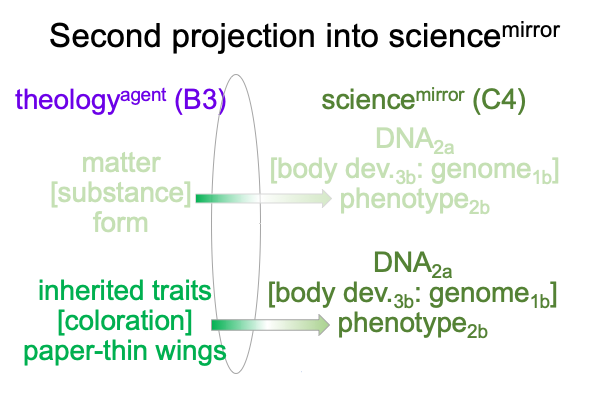0698 At the start of section 1.6, I learn about Aristotle’s law of proportionate causation.
No effect exceeds its cause. The order of causes is commensurate with the order of effects.
0699 Does this translate into a slogan about the hylomorphe, dispositions [properties] powers?
There is no power than transcends its dispositions.
0700 What if a power is adequate enough to show that its underlying disposition is valuable in terms of natural selection?
That is an idea that an evolutionary biologist can appreciate. The disposition would be sustained as an adaptation, and maybe improved upon, especially in its capacity to exploit a niche, where the niche1b is the potential of an actuality independent of the adapting species2a.
0701 Here is what the natural historian studies.
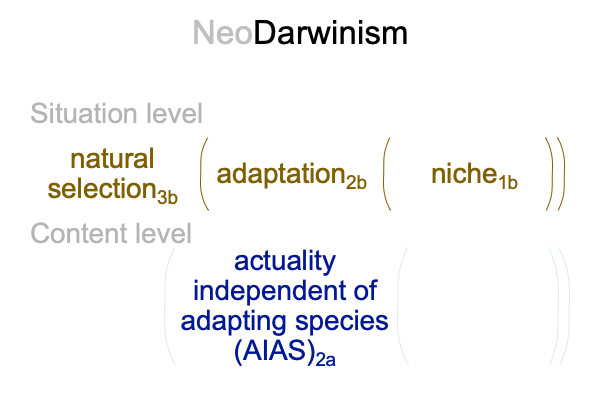
On the situation level, the normal context of natural selection3b brings the actuality of an adaptation2b into relation with its niche1b. The situation-level niche1b is the potential1b of an actuality independent of an adapting species2a. The AIAS2a is often labeled, “the environment of evolutionary adaptation2a” (EEA2a).
0702 Let me offer an example.
The philosopher will tell anyone willing to listen that the moth is a substantial form and the coloration of its wings is an accidental form.
0703 Certain moths have large black dots on their wings. The naive observer notes the pattern and thinks, “Wow. When the moth’s wings are open, they more or less look like the eyes of an owl.”
Maybe, if the naive observer (B1) believes that God is the source of the signs of nature, then he would say, “Look the Creator paints the face of an owl on the wings of a moth (C2).”
0704 The expert guiding the expedition (A3) replies, “Superstitious nonsense. That pattern arises because it deters predation by small birds, who in turn are prey of larger animals. Small birds have an innate fear of looming eyes. Looming eyes indicate a predator. So, small birds have evolved this fear, which the moth’s coloration uses to the moth’s advantage. A moment’s hesitation by a small bird may allow a moth to escape (A3).”
Here is a picture of what the scientifically-trained guide says.
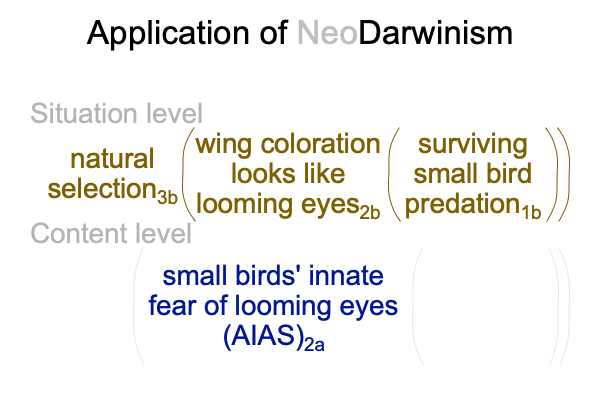
0705 What is the scientist doing in terms of the optics of Tabaczek’s mirror?
Here is a picture.
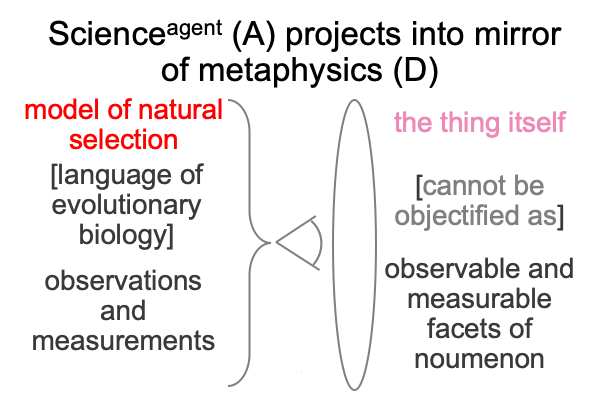
0706 In many respects, the expert (A1) believes that his model should override the thing itself. The remarkable creature that impressed the student is nothing more than an example of natural selection. It is an adaptation2b into the niche of small bird predation1b.
Plus, the phenomenon of moth coloration can objectify the expert’s model of natural selection. The sign-object of the sign-vehicle of the moth’s coloration is the eyes of a looming predator. The sign-interpretant is the mind of a small bird that would eat the moth.
0707 What does the student (and people are more like natural philosophers than scientists) see in theologymirror (D2)?
I suppose that the student (theologyagent (B3)) sees something like the following in theologymirror (D2).
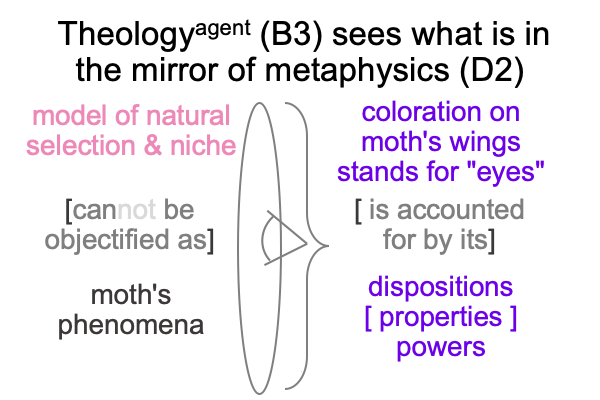
0708 I ask, “Does Aristotle’s law of proportionate causation apply to signs?”
The black circles on the back of a moth’s wings (sign-vehicle) stands for the looming eyes of a large predator (sign-object) to the innate (and confirmed through exposure) fear of a larger predator by a smaller predator (sign-interpretant).
0709 I can ask the same question for a different venue. Does a stop sign stop an automobile?
In 2024, every automobile I see on the road stops at a stop sign.
Both Aristotle (300s B.C.) and Aquinas (1200s A.D.) recognize signs. However, the philosophical tradition does not elucidate the causality of signs until John Poinsot (in the 1600s). In the 1800s, Charles Peirce makes the same discovery as John of St. Thomas. Signs are triadic relations.
0710 This commentary has already introduced sign-relations.
The topic of sign-relations enters into the story around point 0328, immediately preceding the section titled, “Interscopes and Sign Relations” (point 0335). The discussion wraps up after demonstrating how the Creation Story in Genesis 1 is a sign of the evolutionary record (point 0485).
It is important to remember that neither modern science nor premodern philosophy come to grips with the nature of sign relations, mediations, judgments, category-based nested forms or other triadic relations.
So, one must wonder, “Does Aristotle’s law of proportions apply to triadic relations?”
0711 Surely, the law of proportionate causation seems to apply to the student’s reformulation of the phenomena in sciencemirror (D2) in terms of dispositions [and] powers (B3), as well as to the projection of [properties] into sciencemirror(C4).
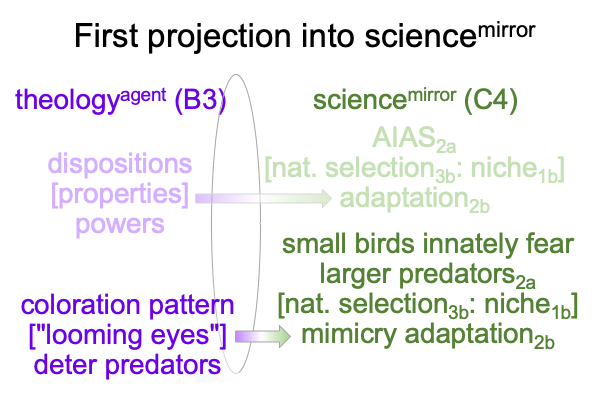
0712 But, the student (B3) cannot stop there.
Why?
Recall how the evolutionary biologist (A1) wants to project a model for natural selection3b and niche1b onto the noumenon, the other source of illumination in the (former) Positivist’s judgment, corresponding to the thing itself (D2)?
What about the geneticist (A1)?
Surely, the geneticist wants to project a model for body development3b and genotype1b onto the noumenon (D2) as well.
So, the current account of the moth’s wings is incomplete.
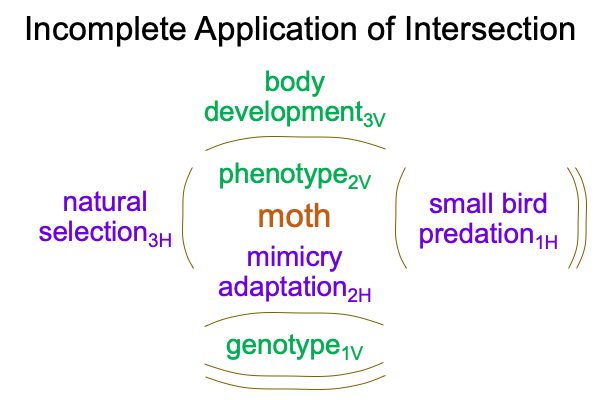
The genetics is missing.
0713 So, when the student (acting as a theologyagent (C3)) makes a snide remark after the guide’s statement (point 704), the certified expert in evolutionary biology is taken aback.
What does the student say?
“Well, I know a geneticist who says that it is all about body development and the expression of DNA.”
